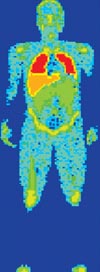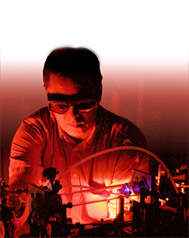About LANL
About Our Capabilities, Facilities, and Staff
"Los Alamos National Laboratory plays an indispensable role in building America as a science and technology powerhouse, and our staff are an incredible resource to the nation and the world." Michael Anastasio, Dir.
Solving Complex R&D Problems with Special Blend of Staff, Capabilities and Facilities
Now in its seventh decade, LANL remains among a very few laboratories that can bring great breadth of fundamental and discovery science, technology, and engineering rapidly together to create tangible solutions for national security needs.
Our staff, working with partners throughout science and industry, must be able to deliver today's solutions while maintaining the depth of capabilities to deliver the next generation of discoveries.
Los Alamos has demonstrated a cycle of innovation where we have developed world-leading capabilities and facilities in response to urgent, unique missions. We also spin out new discoveries that lead to emerging missions.
Being able to integrate and apply our capabilities rapidly to new challenges will be a key advantage in an increasingly competitive landscape.
Our Science, Technology and Engineering Priorities
Science that Matters
- Information science and technology enabling integrative and predictive science
- Experimental science focused on materials for the future
- Fundamental forensic science for nuclear, biological, and chemical threats
How We Work
- Collaborate, partner and team to make decisive contributions to our sponsors
- Outstanding operational excellence for safety, security, and efficient pursuit of ST&E for our missions
Transform Our Scientific Campus
- Campus for 2020 (consistent with complex transformation)
- Modern science facilities: LANSCE refurbishment, CMR replacement, Science Complex
- Signature facilities for experimental science (MaRIE) and computational science (Roadrunner)
More About This Science
The Code Was in the Cards

In 1946, a game of canfield solitaire led Stanislaw Ulam, the Polish mathematician and Manhattan Project pioneer, to a brainstorm. Having returned to Los Alamos, Ulam was temporarily idled by illness and passed the time playing the game. He also pondered the odds of winning any given hand but was stymied by the combinatorial equations needed to exactly solve the probability. Instead, he hit on the idea of using statistical sampling: he would zero in on the probability of a successful outcome by laying out a large number of hands and keeping track of the winners.

Statistical sampling was not original to Ulam, but his musings on cards and chance led to two key insights. He first recognized that statistical sampling was well suited to the problem of neutron diffusion and next realized that the new electronic computers could generate the potential pathways of the neutron through the material. He shared these ideas with Hungarian mathematician John von Neumann, who at the time was a consultant to both Los Alamos and the Ballistics Research Laboratory in Maryland, where the first general-purpose digital computer, the ENIAC, was being built.
Liking the idea, von Neumann in 1947 laid out the neutron diffusion problem in a 19-step computing sheet: in essence, the first Monte Carlo code. The flamboyant name was given to the method by Nicholas Metropolis, architect of Los Alamos' first computers. Ever since then, statistical-sampling computer codes have been known as Monte Carlo codes.
To learn more about how LANL's Monte Carlo code team can assist your research, go to http://mcnp-green.lanl.gov/index.html.
Downloadable resources from the LANL Monte-Carlo Team, such as for medical physics and criticality calculations, are available at http://mcnp-green.lanl.gov/resources.html.
Contact Team Leader Jeremy Sweezy at jsweezy@lanl.gov or 505-665-6204.
Want to know more about the MCNP computer code? Go to the May 2008 issue of 1663.
Safety in Numbers
Monte Carlo code calculations touch many sciences: medical, environmental, engineering

Quick read
From locating water on Mars to aiding the fight against cancer, our Monte Carlo N-Particle computer code is the foundation for methods across a wide array of scientific disciplines.
The Monte Carlo computer code MCNP can tell you how subatomic particles will interact with just about anything. The Los Alamos code has helped scientists find water on Mars and aided doctors battling cancer on Earth.
John Hendricks lets his students play with dice. Most of us associate the little cubes with gambling, but for him they're great teaching tools. Hendricks, a member of Los Alamos National Laboratory's Applied Physics Division, teaches people to use what he says "is one of the Lab's greatest achievements."
MCNP—Monte Carlo N-Particle—is a computer code that has indirectly touched all of our lives. The oil in our cars was likely found with help from engineers using MCNP (or its predecessor versions, or MCNPX, all of which are referred to here as MCNP). The air we breathe was possibly monitored by a system that relies on MCNP, while anyone who has undergone radiation treatment received a dose that was likely calculated and verified by the code.
The uncommon link between these widespread applications is that each requires knowing what happens to radiation—free particles such as neutrons and photons—as it makes its way through matter. Modeling the "radiation transport" of gamma-ray photons through the body can tell you how many will be absorbed by cancer cells, while following the transport of neutrons from a source to a detector, both placed underground, can tell you if the neutrons passed through oil-saturated rock. Computationally, the most accurate way to solve a radiation transport problem is to use random numbers to decide the outcome of a particle's encounters with atoms and nuclei and repeat the process for many particles. It's a physics-based game of chance, and MCNP is the game's most skilled player.
A Game of Chance
MCNP knows the different probabilities from experimental data and uses one random number to choose between reactions (fission, capture, scattering, or other) and others to select a specific outcome—the number of neutrons or other particles produced, their final energies, the direction each taken by each, even how far each goes before encountering a new nucleus. Hendricks and his students obtain them by tossing dice.
Making independent choices for each new encounter, MCNP is able to construct a realistic trajectory of a neutron through the reactor. MCNP can then calculate the rate at which neutrons are produced by fission and the rate at which they are lost.
MCNP is being used by nuclear engineers and scientists at Los Alamos to address one of the more pressing issues of our time—the production of nuclear energy. The goal is to develop new reactors, new nuclear fuels, and enhanced safeguard systems that will make nuclear energy safer, produce less waste, and be resistant to the diversion of plutonium.
Roll of the Dice
How can choosing a random number lead to physically relevant descriptions? John Hendricks explains how to a class of young engineers:
"Suppose that in an imaginary nuclear reactor, there are only four possible outcomes for a neutron-nucleus encounter: (A) The neutron is absorbed and captured by the nucleus, so no neutrons remain after the encounter; (B) the neutron scatters off the nucleus, so one neutron remains; (C) the neutron is absorbed and the nucleus fissions, producing two neutrons; or (D) the nucleus fissions and produces three neutrons.
"Next, imagine that experiments with our nucleus reveal that for every six neutron encounters, (A) happens 3 times,and (B), (C), and (D) each happen once. How do we model this physics?
"We'll be rolling a die that generates a number from 1 to 6 at random and with equal probability. We have to make the six numbers correspond to the four possible outcomes in a way that matches the probabilities that were measured in our experiments. This is done by assigning the die numbers 1, 2, and 3 to (A), 4 to (B), 5 to (C), and 6 to (D). In essence, we've transformed the ‘real world' into an equivalent ‘computational world,' where each encounter now has six outcomes that result in either 0, 0, 0, 1, 2, or 3 neutrons. Because our die is unbiased, each outcome is equally likely to occur, so on average, six rolls of the die will produce a total of six neutrons," exclaims Hendricks.
"To find out how our reactor behaves, we do a Monte Carlo simulation. We'll start with many neutrons in the reactor. Each neutron will encounter a nucleus, and a roll of the die will determine the outcome (how many neutrons remain). We'll then average our results and calculate the uncertainty of our answer. One of MCNP's most powerful features is its use of mathematical shortcuts that reduce the uncertainty without having to ‘roll dice' a million times. Thank goodness for that!”
The engine powering the Materials Test Station (MTS) is the LANSCE facility's 800-million-electronvolt proton beam. When the protons slam into the MTS's tungsten target, copious neutrons will be produced (about 20 per proton-tungsten nucleus collision). MCNP is critical for simulating the results of those collisions and for following the torrent of neutrons as they zip and scatter their way into the candidate fuels.
"We'll measure how much of the fuel's transuranic material fissioned during irradiation," says Eric Pitcher, the test station project manager. "MCNP will tell us the neutron flux, so we'll know how effectively each fuel burns."
While MCNP can tackle any radiation transport problem, it can't model the bulk properties of the reactor materials or predict other types of behaviors. For example, the circulation of the liquid coolant in a reactor needs to be modeled by a "hydrodynamics" code.
Anna Hayes-Sterbenz and her colleagues in the Theoretical Division are developing an "omnibus" design code that combines MCNP with a hydrodynamics code and a nuclear fuel burn-up code. It is also tied to a code that calculates the equation of state of a material, which tells you how the material's properties change.
A final area where MCNP is playing a large role is in nuclear safeguards that keep track of plutonium and other fissionable materials throughout the nuclear fuel cycle.

Table-top lasers compete with large accelerators
George Rodriguez adjusts argon gas pressure inside two-color plasma ionization gas cells
Table-top ultrafast laser based plasma terahertz sources are beginning to rival pulse energies previously obtainable only at large accelerator-based facilities.
Currents, the Laboratory's monthly employee magazine, highlighting people in the workplace.







